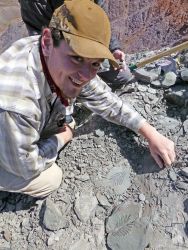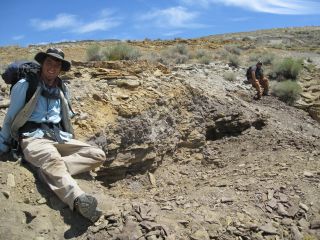By Nathan Jud | PCP PIRE Post Doc
Editor’s Note: PCP PIRE is excited to announce that Dr. Nathan Jud has joined us as a new post-doctoral scholar starting in August. Jud is a paleobotanist with a PhD from the University of Maryland-College Park (2014). He will attend the All Hands meeting in Fort Robinson, NE this August, and be based in Gainesville, FL.

After becoming interested in botany during a high school biology course, I discovered the joys of paleobotany at Ohio University in Athens, where I earned my B.S. in Plant Biology. Over the course of two undergraduate research projects and several classes, I developed a strong background in plant anatomy and morphology. My projects were specimen-based and focused on anatomically preserved (permineralized) plant fossils from the Cretaceous deposits of Vancouver Island, Canada.
For my graduate education, I moved to the Washington, D.C. area to attend the University of Maryland – College Park. The school’s connection with the Smithsonian National Museum of Natural History (NMNH) allowed me to conduct my research at the museum. I focused on the relationship between evolution and ecology in deep time, specifically on the problem of early angiosperm evolution (flowering plants) and the unanswered questions about the ecological setting of their diversification.

Through fieldwork, I created new museum collections of fossil leaves from the Cloverly Formation in Wyoming. I also collected data from existing historical collections at the NMNH. My research indicated that, following the initial appearance of angiosperms, much of the diversity of early angiosperms was comprised of herbaceous plants occupying a variety of habitats at low abundance for millions of years, before the appearance of angiosperm-dominated forests. I also found many unidentified or misidentified fossils of early flowering plants in existing leaf megafossil collections.
Looking ahead to my role as part of the Panama Canal Project, I see myself working to understand the changing composition of Cenozoic neotropical plant communities by engaging students in specimen-based research on permineralized fruits and seeds (similar to the work I did as an undergraduate), and by applying my experience collecting and studying fossil leaves to understand the environments and paleoclimatic conditions under which the plants grew. I am excited to develop questions and projects that will explore the relationship between climate change and plant community change.
Por Nathan Jud | Post Doctorante del PCP PIRE
Nota editorial: El PCP PIRE tiene el agrado de anunciar que el Dr. Nathan Jud se nos ha unido como nuevo investigador post-doctorante. Jud es paleobotánico con un PhD de la Universidad de Maryland-College Park (2014). Él estará presente en la conferencia “All Hands” ha lugar este agosto en Fort Robinson, Nebraska y radicará en Gainesville, Florida.

Después de haberme interesado en la botánica, durante un curso de biología en la escuela secundaria, descubrí las alegrías de la paleobotánica en la Universidad de Athens, donde obtuve mi licenciatura en biología de plantas. Durante el transcurso de dos proyectos de pregrado y varias clases, obtuve experiencia en anatomía de plantas y morfología. Mis proyectos fueron basados en especímenes y centrados en los fósiles de plantas anatómicamente preservados (permineralizados) de depósitos cretácicos de la Isla Vancouver, en Canadá.
Para mis estudios de postgrado, me mudé a Washington, D.C., para asistir a la Universidad de Maryland – College Park. Las conexiones de esta escuela con el Museo Nacional de Historia Natural Smithsonian (NMNH) me permitieron conducir mi investigación en el museo. Me enfoqué en la relación entre evolución y ecología a través del tiempo, específicamente en el problema de la evolución temprana de las angiospermas (plantas con flores) y las preguntas sin responder sobre el marco evolutivo de su diversificación.

A través del trabajo de campo, creé nuevas colecciones museísticas de hojas fósiles de la Formación Cloverly, en Wyoming. También colecté datos de colecciones históricas existentes en el NMNH. Mi investigación señalaba que luego de la aparición inicial de angiospermas, mucha de la diversidad de angiospermas tempranas estaba comprendida por plantas herbáceas que ocupaban una variedad de hábitats de baja abundancia por millones de años, antes de la aparición de bosques dominados por angiospermas. También encontré fósiles de plantas con flores tempranas sin identificar o mal identificados en colecciones existentes de megafósiles de hojas.
Mirando hacia adelante en mi rol como parte del Proyecto del Canal de Panamá, me veo trabajando para entender el cambio en la composición de comunidades de plantas neotropicales del Cenozoico involucrando estudiantes en investigaciones basadas en especímenes de frutas y semillas permineralizadas (similar al trabajo que hice como estudiante de pregrado) y aplicando mi experiencia en la colecta y estudio de hojas fósiles para entender los ambientes y condiciones paleoclimáticos bajo los cuales las plantas crecieron. Estoy emocionado de desarrollar preguntas y proyectos que explorarán las relaciones entre el cambio climático y cambios en comunidades de plantas.